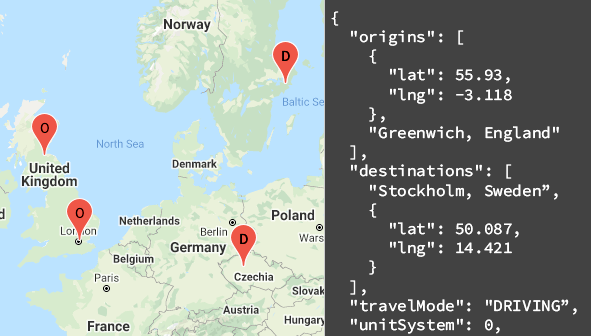مقدمة
Distance Matrix API (الإصدار القديم) هي خدمة تقبل طلب HTTPS يحتوي على نقاط انطلاق ووجهات لوسيلة نقل معيّنة. بالنسبة إلى كل مجموعة من نقطة الانطلاق والوجهة، تعرض هذه الطريقة المسافة المقطوعة ومدة الرحلة.
أسباب استخدام Distance Matrix API
يمكنك استخدام Distance Matrix API للمساعدة في تحديد مسارات السفر الأكثر فعالية بين عدة مصادر ووجهات محتملة. على سبيل المثال، تحديد العمال الذين سيتم إرسالهم إلى مواقع العمل أو المستودعات التي سيتم إرسال الطرود منها.
الإجراءات التي يمكنك تنفيذها باستخدام Distance Matrix API
باستخدام Distance Matrix API، يمكنك توفير مسافة التنقّل ومدة الرحلة لمصفوفة من نقاط الانطلاق والوجهات. يمكنك تحديد عدة خيارات، بما في ذلك وسيلة النقل، مثل القيادة أو ركوب الدراجات أو النقل العام أو المشي، بالإضافة إلى وسائل النقل العام، مثل الحافلة أو مترو الأنفاق أو القطار أو الترام أو السكك الحديدية.
توفّر واجهة برمجة التطبيقات Distance Matrix API معلومات استنادًا إلى المسار المقترَح بين نقطتَي البداية والنهاية. يمكنك طلب أنواع بيانات المسافة التالية:
- المسافة لوضع سفر محدّد
- المسافة بالكيلومترات أو الأميال
- الوقت المقدَّر للسفر في حال الازدحام المروري

طريقة عمل Distance Matrix API
تستخدِم واجهة برمجة التطبيقات Distance Matrix API أي عدد من نقاط الانطلاق والوجهات، وتعرض المسافة ومدة الرحلة بين كل نقطة انطلاق وجميع الوجهات المطلوبة، بدءًا من نقطة الانطلاق الأولى في الطلب والانتقال خطوة بخطوة إلى نقطة الانطلاق التالية.
على سبيل المثال، إذا كان طلبك يحدّد A وB كمصادر، وC وD كوجهات، سيعرض المسافات ووقت السفر بهذا الترتيب:
- من A إلى C
- من A إلى D
- B to C
- من B إلى D
يوضّح المثال التالي طلبًا لمصدرَين: واشنطن العاصمة وبوسطن، مع وجهة واحدة، مدينة نيويورك، نيويورك، بتنسيق JSON:
https://maps.googleapis.com/maps/api/distancematrix/json ?destinations=New%20York%20City%2C%20NY &origins=Washington%2C%20DC%7CBoston &units=imperial &key=YOUR_API_KEY
الموارد
يلخّص الجدول التالي الموارد المتاحة من خلال واجهة برمجة التطبيقات Distance Matrix API، بالإضافة إلى البيانات التي تعرضها.
| موارد البيانات | البيانات التي تم عرضها | تنسيق القيمة التي يتم إرجاعها |
|---|---|---|
| مصفوفة المسافات
قدِّم المصادر والوجهات على شكل أرقام تعريف الأماكن أو العناوين أو إحداثيات خطوط الطول والعرض. |
|
|
كيفية استخدام Distance Matrix API
| 1 | إعداد حسابك | ابدأ بإعداد مشروعك على Google Cloud واتّبِع تعليمات الإعداد التي تلي ذلك. |
| 2 | تجربة طلب مصفوفة المسافة | بعد الحصول على مفتاح واجهة برمجة التطبيقات، يمكنك بدء تجربة Distance Matrix API مباشرةً من متصفّحك. يمكنك الاطّلاع على نماذج الطلبات في دليل البدء للحصول على أمثلة. |
| 3 | إنشاء طلب أكثر تعقيدًا | حاول تقديم طلب يوفر مصادر ووجهات متعددة. تعرف على المعلمات الاختيارية لتقييد العمليات الحسابية، مثل وقت المغادرة المحدد، أو قيود الطريق. راجع المعلمات الاختيارية في دليل طلب واستجابة مصفوفة المسافة. |
| 4 | فهم أساسيات الاستجابة | استكشِف ردود البيانات للاستعداد لاستخدام بيانات مصفوفة المسافة في تطبيقك. راجِع ردود مصفوفة المسافة لمعرفة التفاصيل. |
| 5 | دمج بيانات مصفوفة المسافات في تطبيقك | يمكنك استخدام هذه البيانات لحساب مسافة التنقّل ومدته. |
مكتبات العملاء المتاحة
يمكنك طلب بيانات من واجهة برمجة التطبيقات هذه باللغة التي تختارها من خلال إحدى مكتبات البرامج التالية:
- Java Client for Google Maps Services
- برنامج Python العميل لخدمات "خرائط Google"
- Go Client for Google Maps Services
- Node.js Client for Google Maps Services
إنّ Java Client وPython Client وGo Client وNode.js Client لخدمات "خرائط Google" هي مكتبات عملاء متاحة للجميع ومفتوحة المصدر بموجب ترخيص Apache 2.0. يمكنك تنزيلها من GitHub، حيث يمكنك أيضًا العثور على تعليمات التثبيت ونموذج الرمز البرمجي.
الخطوات التالية
- بدء استخدام "مصفوفة المسافات": انتقِل إلى البدء.
- البدء باستخدام نماذج الطلبات والردود: انتقِل إلى طلب وردّ في Distance Matrix.
- اتّباع أفضل الممارسات: انتقِل إلى أفضل الممارسات المتعلّقة بخدمات الويب.

